Best Product Fruits Alternatives for SaaS
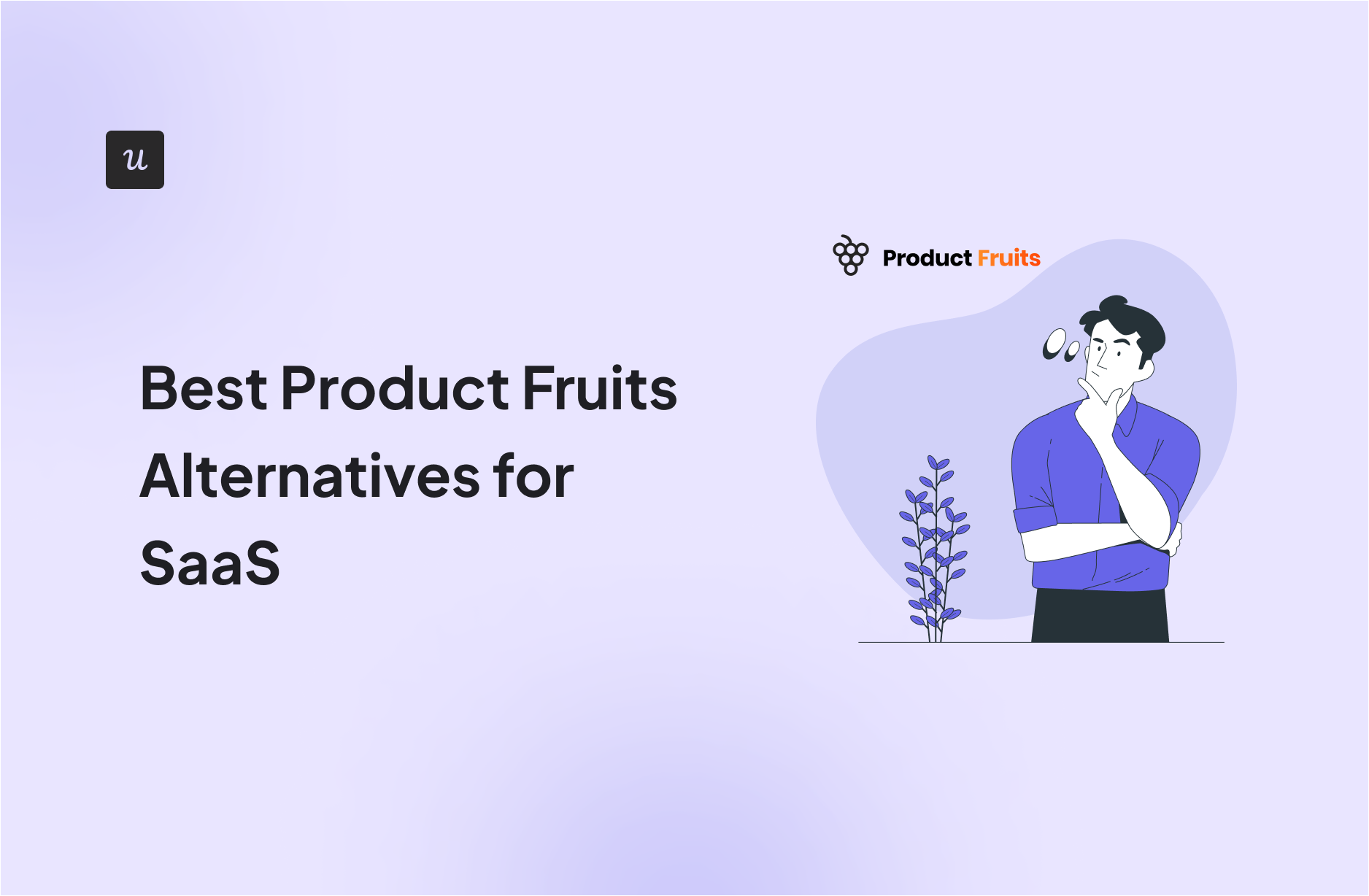
Exploring alternatives to Product Fruits? With plenty of choices available, it’s difficult to decide which one will be the right fit.
The crux of the issue is – to make the right choice, you need to account for your priorities: your different jobs to be done, your budget, and the size of the company. But don’t worry – we’re coming to help!
In this post, we’ll discuss exactly that – which Product Fruits competitor is best depending on the different use cases.
Let’s dive in!
TL;DR
- Product Fruits is a platform designed to help you tackle issues related to software adoption. With a focus on seamless customer onboarding, this tool allows companies to create engaging in-app journeys. The platform provides insights into successful practices, guiding you toward steady business growth. Best of all, you don’t need any coding skills to get started with Product Fruits.
- Let’s explore typical situations where Product Fruits may not meet your user onboarding requirements, and it would be beneficial to consider an alternative:
- You need advanced segmentation and personalization: Despite Product Fruits providing basic user segmentation, it falls short when compared to alternatives like Userpilot, which offers comprehensive, contextual capabilities. Userpilot enables multi-language flows with its AI-driven translation service and has no user segmentation limits. It promotes effective feedback collection through milestone trigger surveys and NPS surveys for gauging product sentiment. If a user is struggling with onboarding, Userpilot sends personalized in-app messages to aid them.
- You want advanced analytics: Userpilot outshines Product Fruits with its analytics prowess. It helps deeply comprehend user behavior and sentiment without coding or API hassles. Userpilot tags your chosen features for accurate tracking and employs a heatmap to visualize your users’ activity patterns. Additionally, Userpilot provides live monitoring of your checklists, turning raw data into practical insights.
- You need more survey templates and better survey analytics: Userpilot surpasses Product Fruits by offering more survey templates for user experience improvement, product research, customer satisfaction, and sales attribution. The analytics feature allows for filtering by segment, company, and timeframe, delivering metrics tailored to your requirements. Userpilot also provides a series of numerical charts to give a comprehensive overview of your survey’s performance. This includes total views, completion rate, and average completion time.
- Here are the top Product Fruits alternatives you can consider:
- Userpilot is a product growth platform that drives user activation, feature adoption, and expansion revenue. It also helps product teams collect user feedback, streamline onboarding, and gather actionable insights from analytics. With Userpilot, you’ll be able to track both product usage and user behavior to get a holistic view of how customers use your product — which will guide future development, improve the user experience, and inform your growth efforts.
- UserGuiding is a no-code product adoption tool that lets users create in-app walkthroughs, guides, and checklists. The solution makes it possible for teams to onboard, engage, and retain users without needing coding skills to create these in-app experiences. All in all, UserGuiding is a pretty flexible solution that can improve the onboarding process, boost user engagement, and increase customer retention.
- Userflow is a user onboarding solution centered around building in-app flows and guides quickly and seamlessly. It helps product teams onboard new users, creates guides/checklists, and surveys customers to gather valuable feedback. Each flow has its own analytics that shows how many views each step of a funnel gets and what percentage of users end up seeing a particular stage. Lastly, the flow builder (Userflow’s main feature) also has versioning capabilities so you can restore your flows to a previous variant.
- Whatfix is a digital adoption platform that helps enterprise organizations with onboarding, training, and supporting their employees or customers. It accomplishes this through in-app guidance and messaging to provide on-demand support whenever it’s needed. The solution also lets you track analytics on all in-app guidance, collect user feedback, build out self-serve content, and automate certain flows. Whatfix even has integrations with Salesforce, Amplitude, Google Analytics, Slack, Confluence, and other platforms to maximize collaboration.
- Interested in driving product growth without coding? Book a demo to see how we can help!
What is Product Fruits?
Product Fruits is a platform designed to help you tackle issues related to software adoption. With a focus on seamless customer onboarding, this tool allows companies to create engaging in-app journeys.
The platform provides insights into successful practices, guiding you toward steady business growth. Best of all, you don’t need any coding skills to get started with Product Fruits.
What are the main use cases for Product Fruits?
Understanding the core functionalities and use cases of Product Fruits is crucial for deciding whether or not it’s the right choice for you.
Without further ado, let’s see the primary scenarios where Product Fruits is useful for your SaaS business!
Product Fruits for user onboarding
If you’re looking for a tool to simplify your user onboarding process, Product Fruits can be your go-to. This software teaches your customers the ins and outs of your product. Moreover, its affordability makes it an appealing choice for budget-conscious small startups.
Here’s why Product Fruits can shine in your onboarding toolkit:
- Product Tours: Product Tours are a great way to welcome and introduce new users to your product. With Product Fruits you can craft step-by-step guides and embed videos from YouTube or Vimeo for interactive understanding. You can create cards that highlight your unique selling propositions to generate excitement. Additionally, the tours offer the option for users to initiate further exploration via a hint icon or special button. Want insights of your product tour? use Product Fruits Analytics features. It offers data on user interactions, completion rates, time spent, and more, helping you fine-tune your tours.
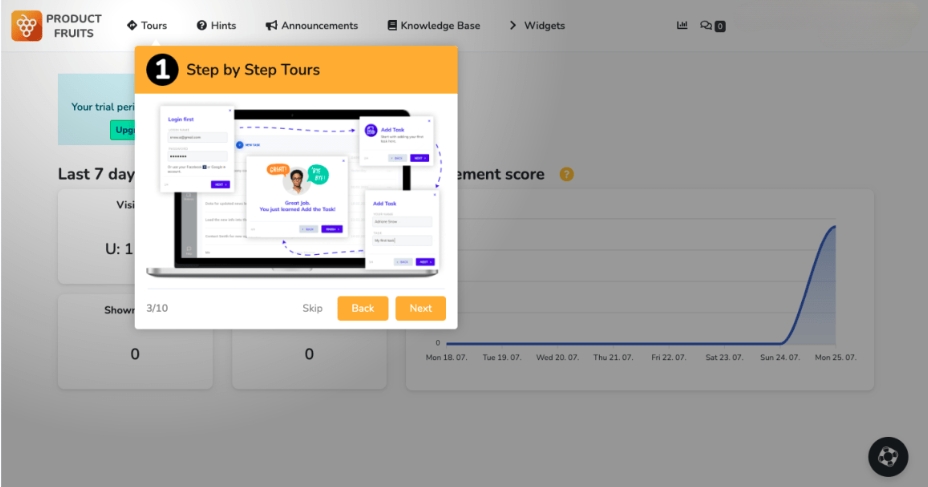
- In-app Announcements: Product Fruits uses pop-ups that appear over all other content, ensuring that users will see these messages before product tours. These pop-ups can be utilized for one-time announcements and are considered one of the best ways to share promotional content. Alongside pop-ups, Product Fruits offers a newsfeed feature. It lets you publish updates about your product in various formats. The newsfeed widget can be embedded into your application and will appear when a user clicks on an icon. A common practice is to use a bell icon accompanied by a badge showing the number of unread newsfeed items.
- Knowledge Base: This constitutes a database of information that users can use for assistance at any time. It simplifies article version management, allowing you to create work-in-progress versions and publish updates to production without altering the URL. Moreover, it’s possible to launch your help center on a personalized domain and integrate it into the structure of your website. The Life Ring Button allows users to directly access your web-based application’s knowledge base from anywhere on your product. And the best part? You don’t need any coding to do that.

Product Fruits for product analytics
Product analytics tools are a game changer when it comes to accelerating your product’s growth. They provide a clear view of your users’ actions within your product and the reasons behind them. However, if you’re seeking top-notch user analytics, Product Fruits might not be your first choice.
That being said, Product Fruits does offer some basic user analytics:
- User Behavior Tracking: Product Fruits provides insights into how your users navigate your product. While it may not delve as deeply as more advanced analytics tools, it still offers valuable insights.
- Performance Metrics: If you want to gauge the success of your onboarding process, Product Fruits offers basic metrics such as completion rates and time spent.
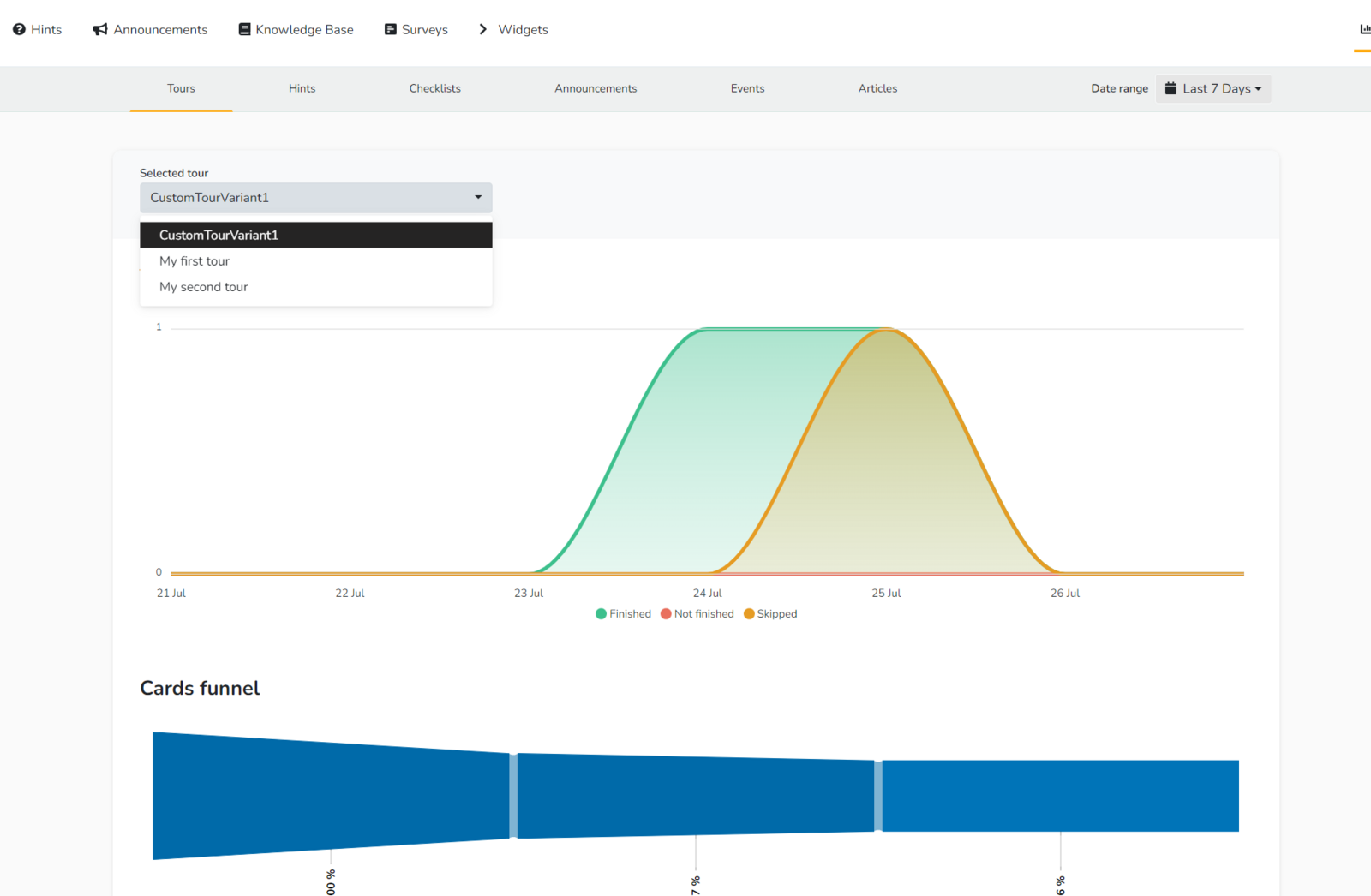
- A/B Testing: To boost user engagement, reduce bounce rates, and increase conversion rates effectively, Product Fruits supports A/B testing. For A/B testing of Product Fruits tours or hints, Google Optimize is the recommended tool. Unlike Userpilot, Product Fruits does not offer in-app A/B testing.
If you’re looking for advanced product analytics, consider checking out Userpilot. This tool goes the extra mile, offering in-depth user segmentation, goal tracking, and A/B testing. The insights it provides can make a significant difference in understanding user behavior and fine-tuning your onboarding process.
Product Fruits for self-service support
Providing top-notch customer support is a crucial part of retaining users and driving product adoption. But it isn’t enough to handhold users via different channels, such as email, phone, and ticketing systems. Modern users expect flawless self-service functionalities when using an app.
Self-service support is an excellent tool to eliminate points of friction from the user journey. Also, it reduces ticket volume and minimizes the burden on your support team. That, in turn, helps them address more serious concerns promptly.
As you’d expect from any digital adoption platform, Product Fruits offers a few handy features to implement self-service support. These include:
- You can use the Knowledge Base option in your workspace to create insightful content that handholds users through your app. The best part is that the articles are automatically added to your in-app knowledge base. The article editor is easy to use and quite comprehensive as well. You can also preview your articles before they’re published.

- You can create different categories and add articles to these to make it easier for users to find what they’re looking for.

- Product Fruits gives you reasonable control over the look and feel of your knowledge base without the need to do any coding.
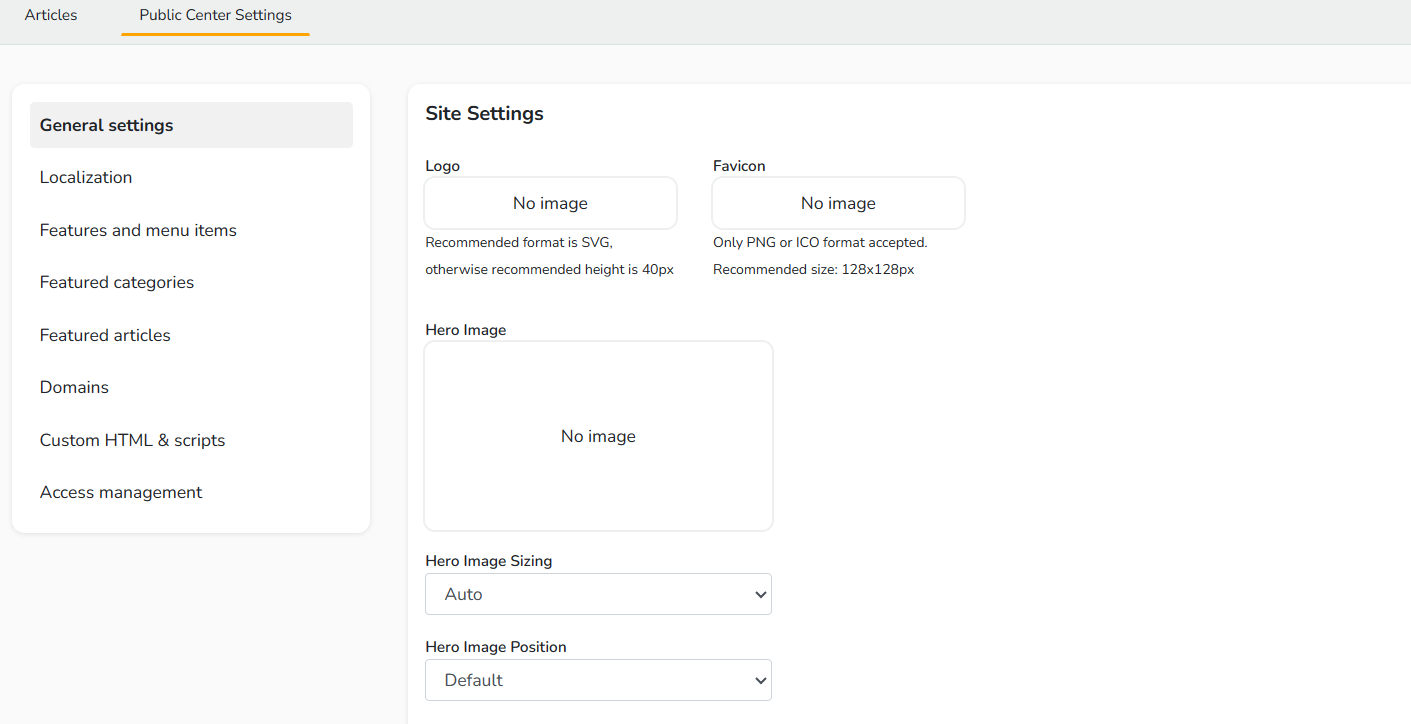
- Besides adding an always-available knowledge base, you can also use the life ring button widget to enable self-service support. It helps you build an in-app help center where users can search for support documentation, access product walkthroughs and guides, and even provide feedback. You can also integrate it with a third-party chat widget to implement the live chat functionality.
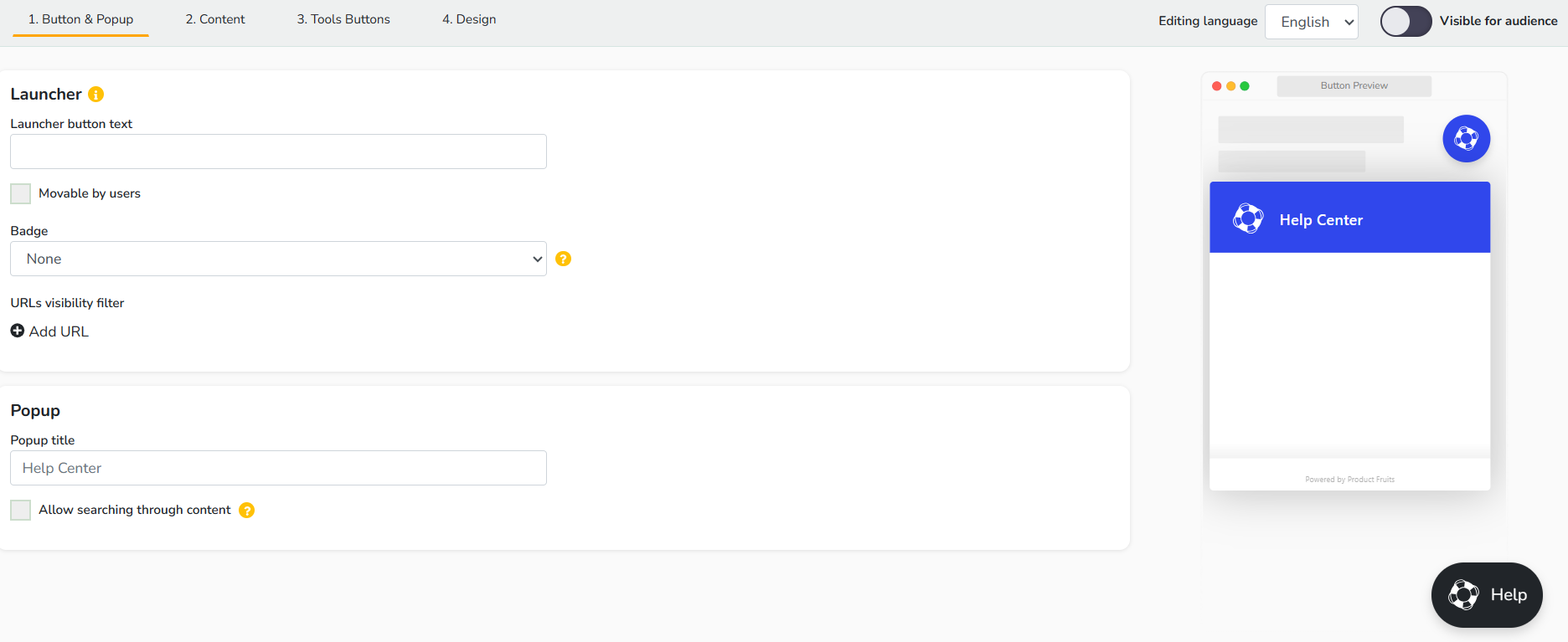
What are the pros and cons of Product Fruits?
Pros of Product Fruits?
Product Fruits offers many benefits with its easy-to-use, no-code platform. It is one of the good solutions for companies looking for affordable user onboarding, product adoption, and product analytics.
So, what does Product Fruits bring to the table? Let’s explore its promising pros:
- Guided Product Tours: It guides users to learn about your app through step-by-step tours for new features.
- Newsfeed: Enhance your users’ connectivity by sharing updates about your product. Additionally, you can set specific newsfeed items which will be displayed in the knowledge base.
- Feedback Through Screenshots and Videos: This feature allows users to send screenshots or videos directly within the app to provide feedback.
- Tooltips: These are brief hints added to different parts of the application to guide users and prevent confusion
- Life Ring Button: A comprehensive support hub that combines all guidance and support resources in one location. This allows users to conveniently access onboarding flows, support documents, and tutorials, no matter what page they’re on.
- Custom Events: Trigger actions based on what users do in your app for more personal interaction.
- Segmentation: Create unique experiences for different types of users and show tailored content to separate user groups.
- Analytics: Gain valuable insights into user behavior, identify improvement areas, and address pain points effectively.
- AI Writer: This feature instantly generates your onboarding copy. However, it is only available in higher-tier plans.
Cons of Product Fruits?
While Product Fruits does have its merits, it’s not without its share of issues. Let’s see some potential drawbacks that might have you considering alternatives.
- Absence of A/B Testing: Product Fruits lacks A/B testing, a vital feature for refining your product tours based on user responses and data-backed insights.
- Basic Analytics: Product Fruits does not offer in-depth analytics as its competitors like Userpilot. This makes it difficult to evaluate user interaction and the success of your onboarding
- Insufficient Segmentation Options: The segmentation options here are only based on user attributes. This means you can’t highlight particular app functions or experiences based on a user’s past actions in your app, which can limit the customization of their experience.
- Missing Event-Based Triggering: The absence of real-time triggers may limit timely content delivery. This could affect the success of all in-app flows, such as product tours, tooltips, walkthroughs, modals, etc.
- Complex Tour Configuration: Configuring tours with specific conditions, especially when tuning CSS selectors, can be challenging and time-consuming.
- Limited Integrations: This tool links up with analytic tools, which is great. However, it doesn’t go beyond that. You won’t be able to bring in your resource center materials or link up your CRM unless you’re a Hubspot user.
What do users say about Product Fruits?
Product Fruits has plenty to offer, and many users think so too. Let’s see what people love about this tool:
“Easy to use, for a seamless onboarding experience” I can create (onscreen tutorial) tours, hints, and checklists without having programming knowledge. The support team usually answers all questions within a few minutes, and larger problems are discussed personally in a short Teams meeting.” — Liv S.
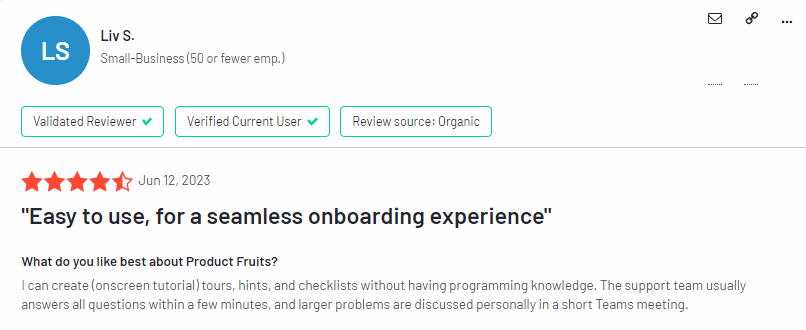 Product Fruits has its fans, but there are also disappointed users. Let’s look at its drawbacks according to some users:
Product Fruits has its fans, but there are also disappointed users. Let’s look at its drawbacks according to some users:
“The product itself is very good, however it could have more robust analytics and more customizable and organized knowledge base with content viewing permissions and FAQ tool.” — Gustavo v.
Does Product Fruits fit your budget?
The platform offers two distinct plans. Each of these plans is tailored to accommodate the number of users you have. Here’s a detailed breakdown of each plan:
- Core: $89/month for 1,500 users. This package includes features like tours & walkthroughs, a knowledge base, and basic integrations. Notably, the onboarding checklist is limited to three items, and there’s also a Life Ring Button for support and announcements feature.
- Boost: $149/month for 1,500 users. This package contains everything in the Core plan, with added benefits such as custom event triggers, advanced integrations, and an AI writer. It also includes features like NPS & Surveys, and access management, ensuring a smoother user experience.
- Enterprise: This plan is custom-priced according to your needs. It’s meant for larger organizations requiring features like SAML SSO, custom terms & conditions, SLA, and bespoke features and integrations.
Core plan is reasonably priced but may not provide the depth of features that a growing company might require. Hence, the Boost plan offers more comprehensive user onboarding and engagement tools. The customizable Enterprise plan is a more appropriate choice for organizations with specific requirements.
You can easily subscribe to any pricing plan without a credit card. Plus, there’s a 14-day free trial on offer. Opting for the yearly plan can be cost-effective, saving $20 on any plan.
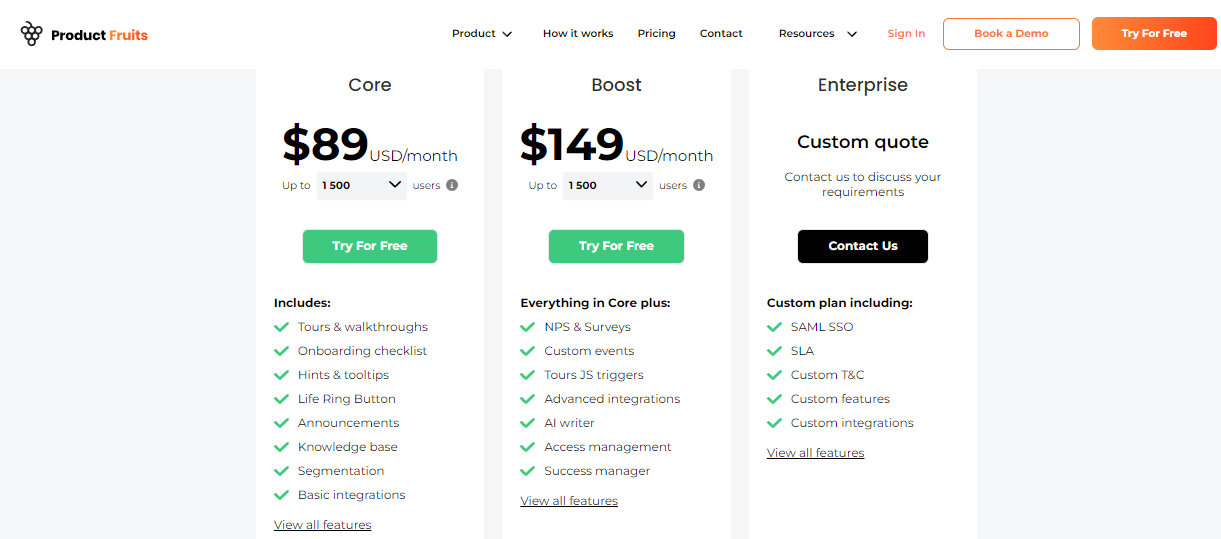
3 Reasons why you might need a Product Fruits alternative
Let’s explore typical situations where Product Fruits may not meet your user onboarding requirements, and it would be beneficial to consider an alternative:
- You need advanced segmentation and personalization: Despite Product Fruits providing basic user segmentation, it falls short when compared to alternatives like Userpilot, which offers comprehensive, contextual capabilities. Userpilot enables multi-language flows with its AI-driven translation service and has no user segmentation limits. It promotes effective feedback collection through milestone trigger surveys and NPS surveys for gauging product sentiment. If a user is struggling with onboarding, Userpilot sends personalized in-app messages to aid them.
- You want advanced analytics: Userpilot outshines Product Fruits with its analytics prowess. It helps deeply comprehend user behavior and sentiment without coding or API hassles. Userpilot tags your chosen features for accurate tracking and employs a heatmap to visualize your users’ activity patterns. Additionally, Userpilot provides live monitoring of your checklists, turning raw data into practical insights.
- You need more survey templates and better survey analytics: Userpilot surpasses Product Fruits by offering more survey templates for user experience improvement, product research, customer satisfaction, and sales attribution. The analytics feature allows for filtering by segment, company, and timeframe, delivering metrics tailored to your requirements. Userpilot also provides a series of numerical charts to give a comprehensive overview of your survey’s performance. This includes total views, completion rate, and average completion time.
Better alternatives to Product Fruits
Considering alternative options to Product Fruits can often lead to discovering more tailored solutions that better suit your needs. Here are the top Product Fruits alternatives you can consider:
- Userpilot is a product growth platform that drives user activation, feature adoption, and expansion revenue. It also helps product teams collect user feedback, streamline onboarding, and gather actionable insights from analytics. With Userpilot, you’ll be able to track both product usage and user behavior to get a holistic view of how customers use your product — which will guide future development, improve the user experience, and inform your growth efforts.
- UserGuiding is a no-code product adoption tool that lets users create in-app walkthroughs, guides, and checklists. The solution makes it possible for teams to onboard, engage, and retain users without needing coding skills to create these in-app experiences. All in all, UserGuiding is a pretty flexible solution that can improve the onboarding process, boost user engagement, and increase customer retention.
- Userflow is a user onboarding solution centered around building in-app flows and guides quickly and seamlessly. It helps product teams onboard new users, creates guides/checklists, and surveys customers to gather valuable feedback. Each flow has its own analytics that shows how many views each step of a funnel gets and what percentage of users end up seeing a particular stage. Lastly, the flow builder (Userflow’s main feature) also has versioning capabilities so you can restore your flows to a previous variant.
- Whatfix is a digital adoption platform that helps enterprise organizations with onboarding, training, and supporting their employees or customers. It accomplishes this through in-app guidance and messaging to provide on-demand support whenever it’s needed. The solution also lets you track analytics on all in-app guidance, collect user feedback, build out self-serve content, and automate certain flows. Whatfix even has integrations with Salesforce, Amplitude, Google Analytics, Slack, Confluence, and other platforms to maximize collaboration.
Let’s see the features and functionalities of these tools for different use cases!
Product Fruits vs Userpilot
There are many ways in which Userpilot is different (and in a lot of ways better!) from Product Fruits. Let’s explore the features of Userpilot, how it’s better than Product Fruits, and how it may fall short too.
Userpilot for user onboarding
User onboarding is a crucial part of the customer journey as it speeds up the adoption process and increases retention rates. Onboarding is one of Userpilot’s core use cases along with product growth analytics and user feedback, so it has plenty of features that you can utilize.
Here are some Userpilot features you can use when onboarding new users:
- No-code builder: Creating flows with Userpilot is as simple as installing the Chrome extension, selecting the UI patterns you’d like to use, and then editing the content/settings to suit your use case. You can also use templates to create modals, slideouts, tooltips, and driven actions.

No-code flow builder in Userpilot.
- Native tooltips: Userpilot lets you create native tooltips that show up when users hover over an element or click on an information badge. Since these native tooltips attach to the element itself, they aren’t page-dependent and will show up on any screen where that element is visible.

Build native tooltips with Userpilot.
- Advanced flow settings: With advanced condition settings, you can decide when, where, and who you’ll be triggering your onboarding flows. This helps you create contextual and personalized onboarding experiences that drive engagement and adoption.
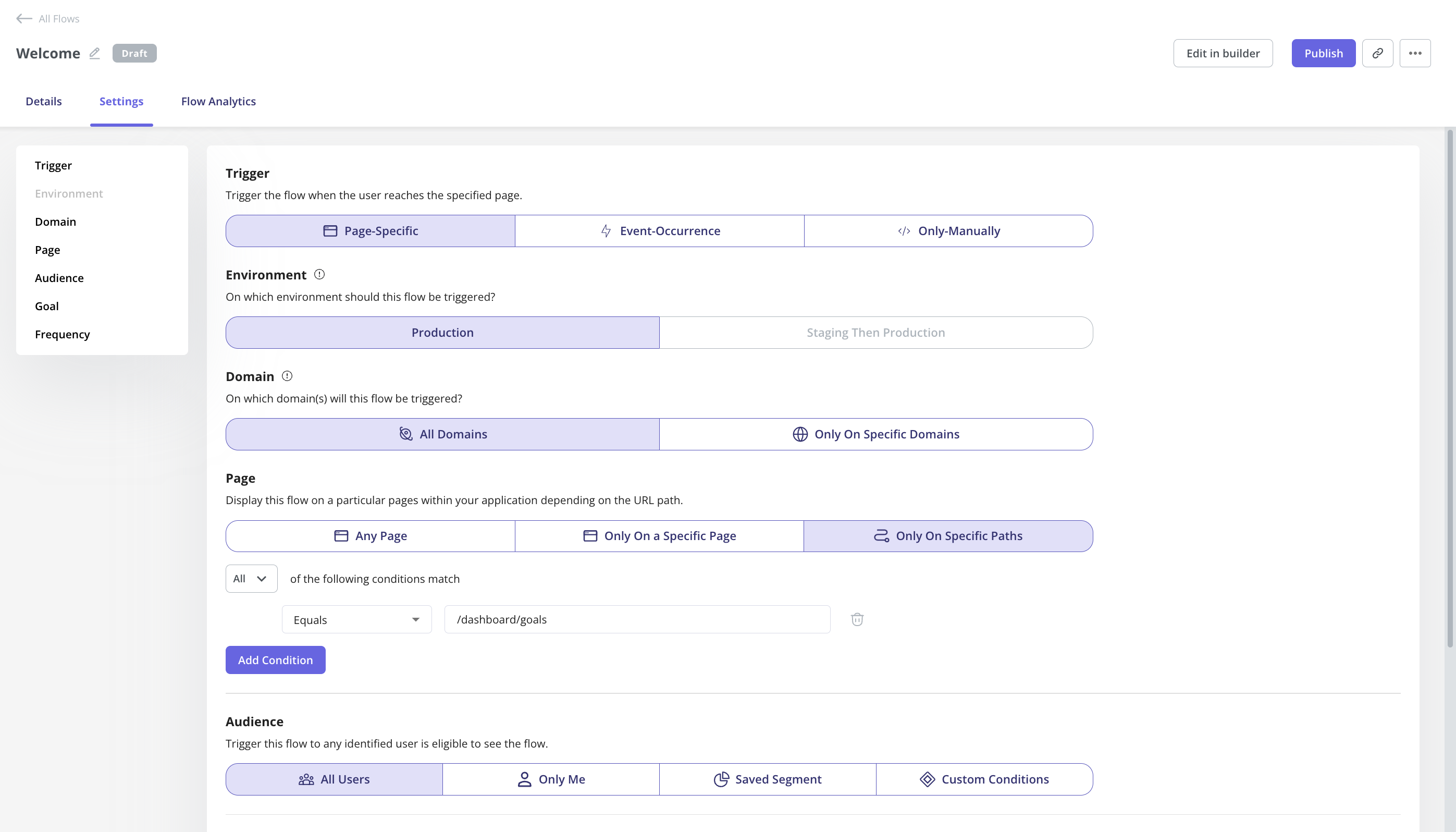
- Onboarding engagement analytics: You can easily assess the impact of your onboarding flows, guidance, etc. by analyzing the engagement rate of tooltips, interactive walkthroughs, checklists, etc. In addition, you can also build reports (funnels, paths, etc.) or dashboards to track your core onboarding metrics i.e. activation, stickiness, drop-offs, etc.
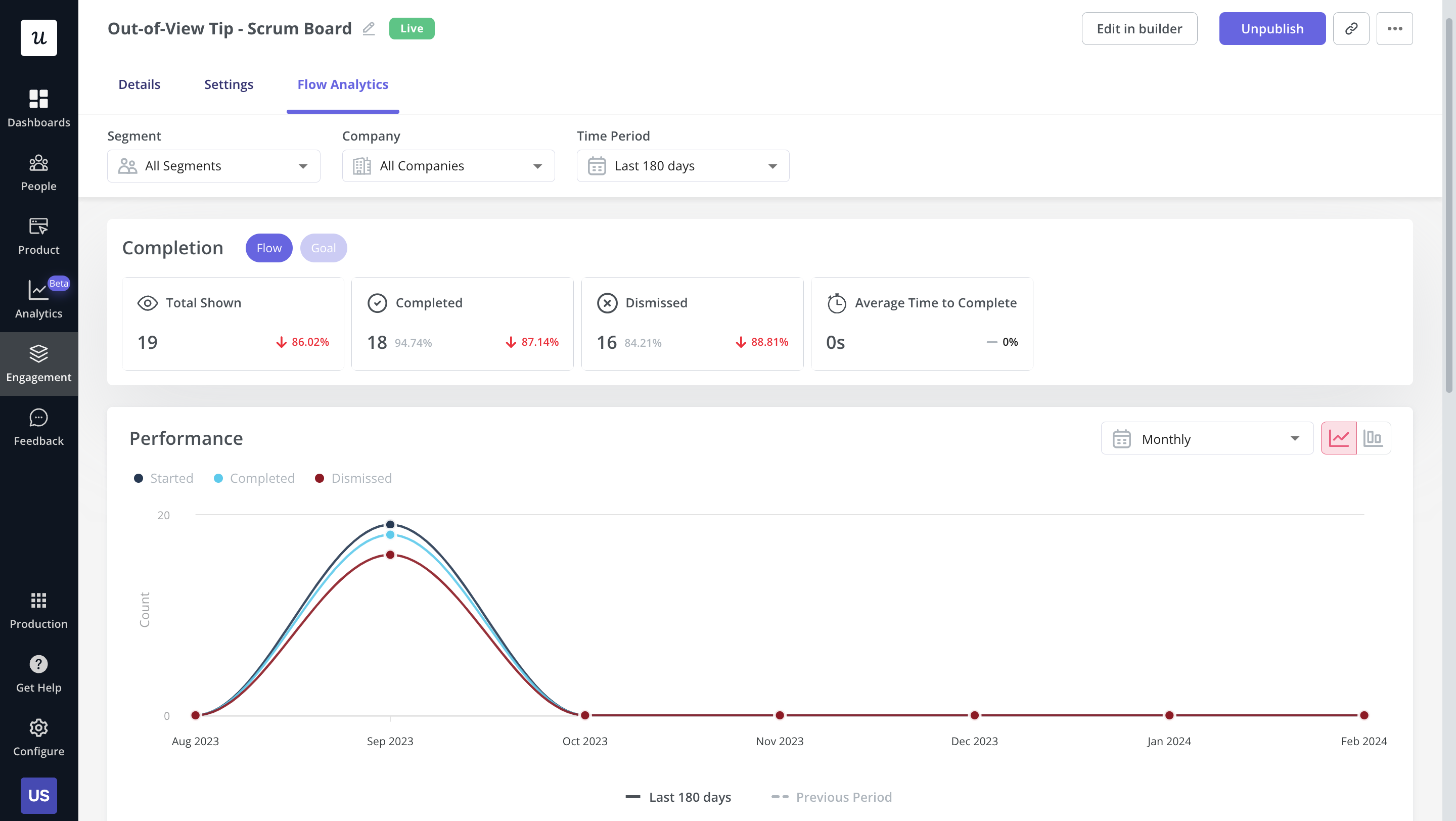
Userpilot for product analytics
Product analytics lets you collect and analyze data about how users interact with your product so you can extract actionable insights. Userpilot lets you look at granular product analytics, such as which features have the highest adoption rates, and big-picture insights like trend reports. Here are Userpilot’s top product analytics features:
- Feature tagging: Userpilot’s click-to-track feature tagger lets you view how many times a feature has been used and by how many users to measure its adoption. Users on the Starter plan can add up to 10 feature tags while those on the Growth or Enterprise tier can create unlimited tags.
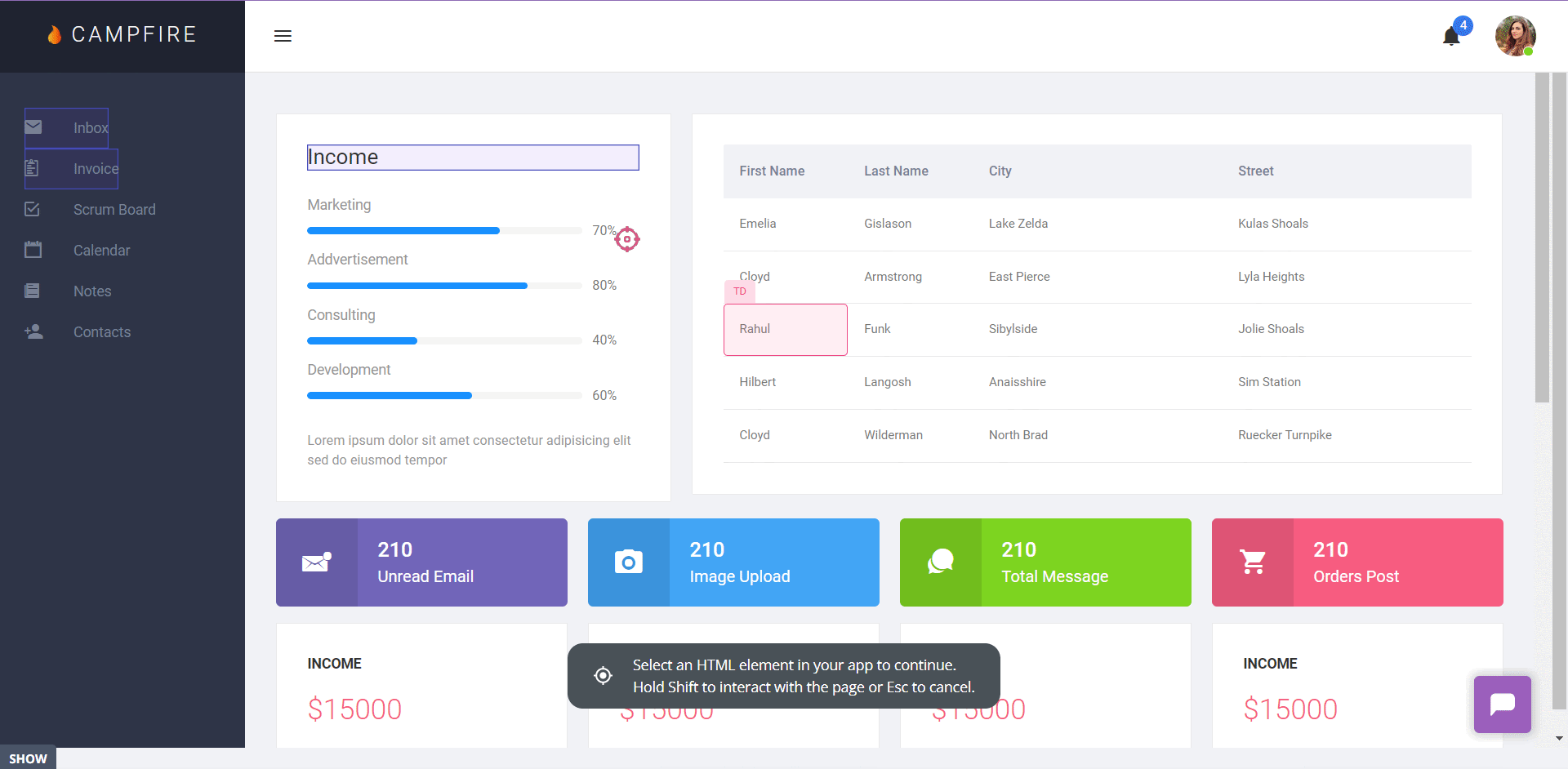
No-code feature tags in Userpilot.
- Event-tracking: Alongside no-code feature tags for feature engagement tracking, you can also track other events unique to your product using event-tracking. You can also create a group of events to track a specific process i.e. onboarding, subscription, etc.
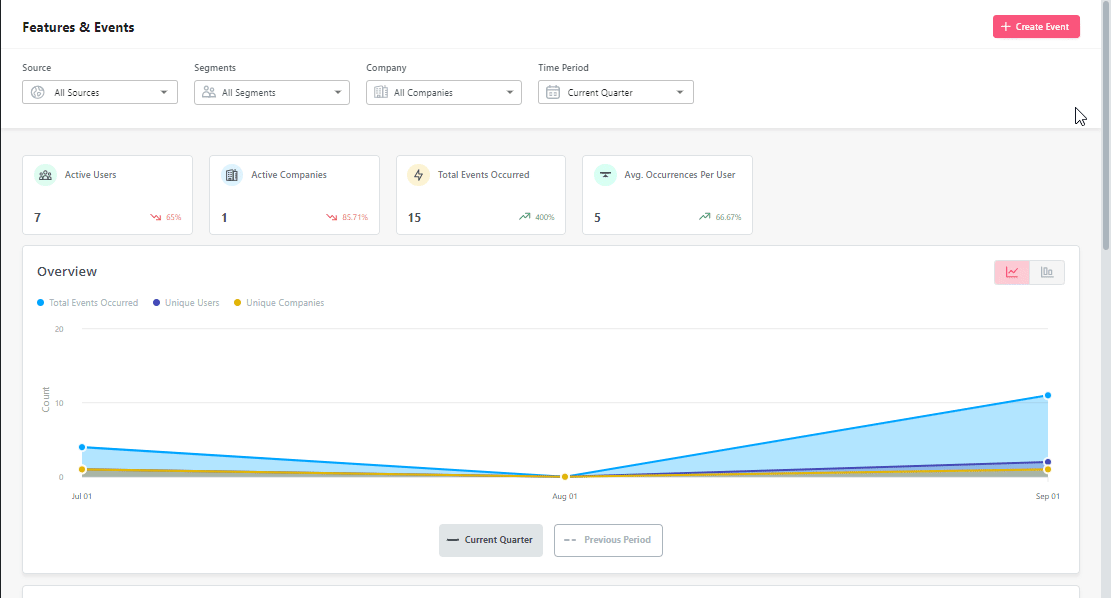
Create tracked events to monitor server-side data.
- Trends and funnels: Userpilot’s trends and funnels report lets you extract actionable insights from big data. You’ll be able to see which stage of an onboarding/conversion funnel most users drop out on and create trend reports with detailed breakdowns by user or period.
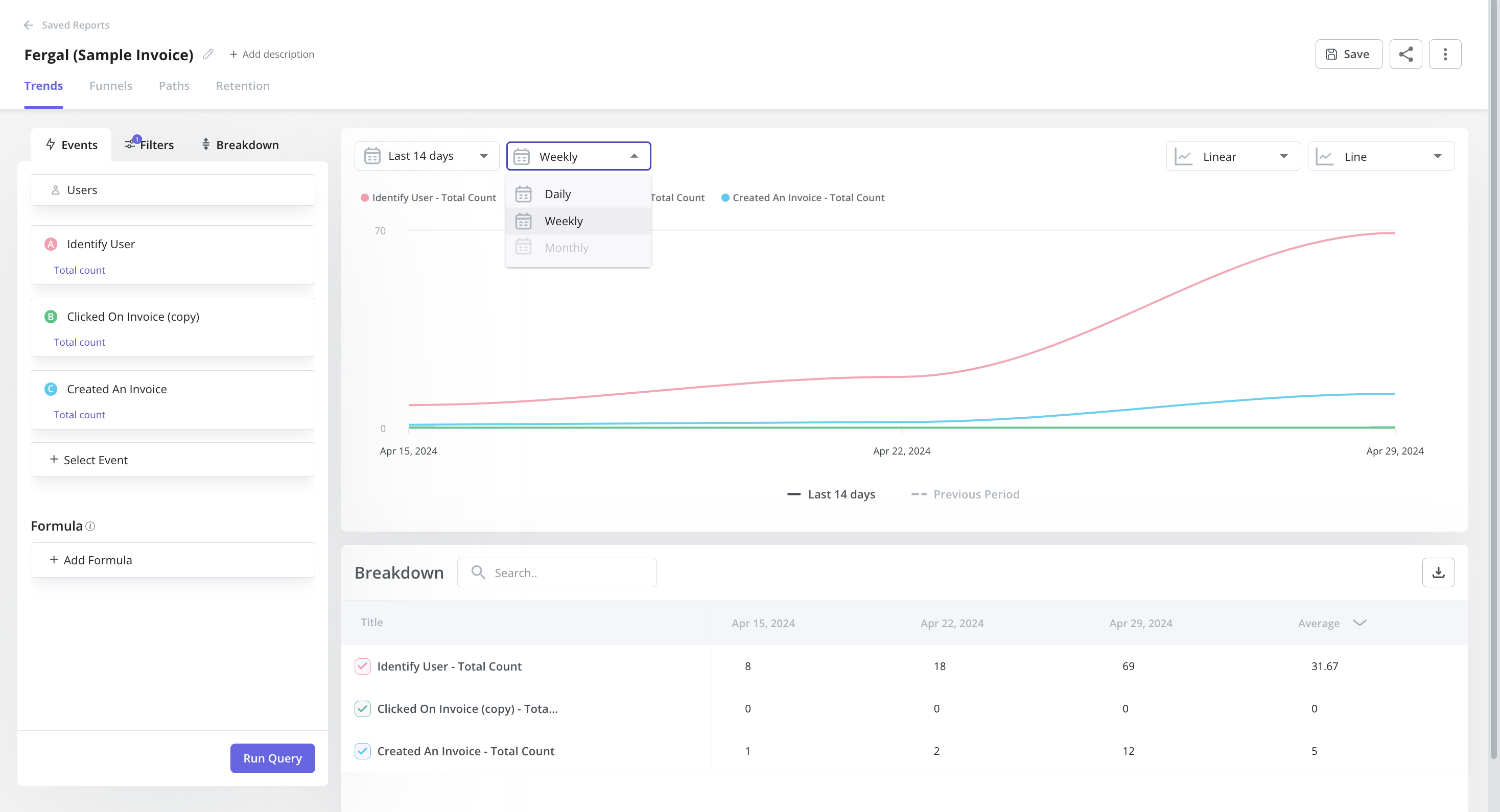 Example of a trend report in Userpilot.
Example of a trend report in Userpilot. - Retention tables: This lets you gauge product performance – how effective it is at retaining users using cohort tables and retention curves.
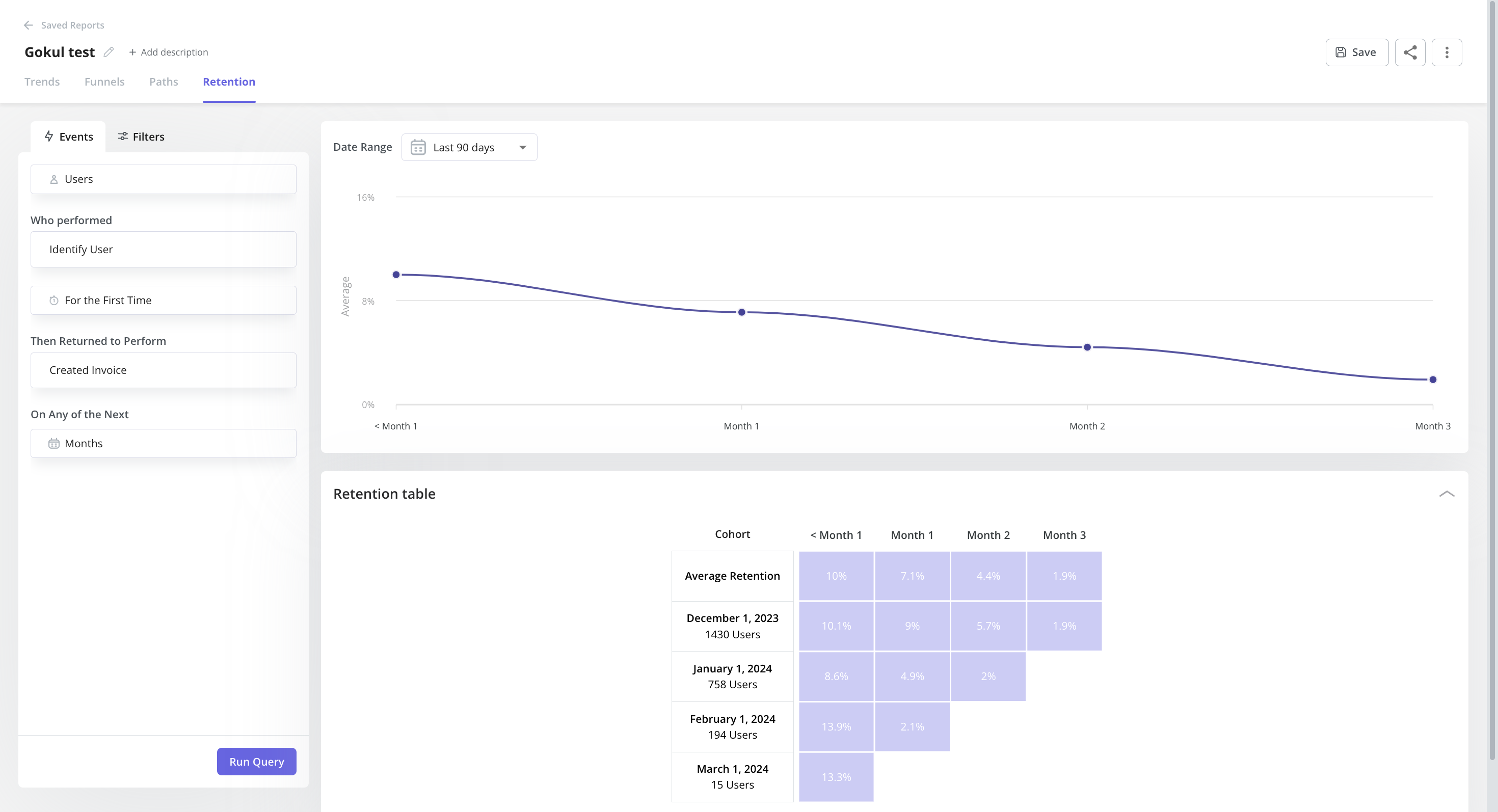
- Paths: You can generate and access path reports directly within the reporting builder in Userpilot, alongside funnels, trends, and retention reports. With Paths, you can have an overview of how users navigate your product features – offering invaluable insights into their interactions with your products.

- User & Company profiles: Here you can view data related to a certain user/company to gain insights into their behavior and improve the overall user tracking experience. This helps you understand how they engage with your product or platform, better identification of areas of improvement, and tailor their offerings more effectively.
 User profile with top event data that provides insights into what feature they regularly engage with
User profile with top event data that provides insights into what feature they regularly engage with - Analytics dashboards (Product Usage, New Users Activation, Core Feature Engagement, User Retention, etc.): These dashboards enable you to keep track of your key product performance and user behavior metrics at a glance, without any technical setup required.

- Analytics integrations: Userpilot integrates with some of the most popular analytics tools like Amplitude, Mixpanel, Segment, Google Analytics, and more. This makes it possible to sync product analytics both ways between the tools in your tech stack (two-way integration is only available for Hubspot at the time of writing, more to come).

Userpilot for self-service support
Here’s how you can use Userpilot to create a self-service customer experience:
- No-code builder: Userpilot’s no-code resource center lets you add modules without writing a single line of code. Module options include links, videos, flows, custom JavaScript functions, and checklists. You can also group modules into sections to help users navigate the resource center.

Add different types of content to your resource center.
- Module segmentation: Userpilot’s segmentation settings let you hide or show specific modules within your resource center based on audience settings. This makes it possible to create modules for different user segments and hide resources that aren’t relevant to other users.
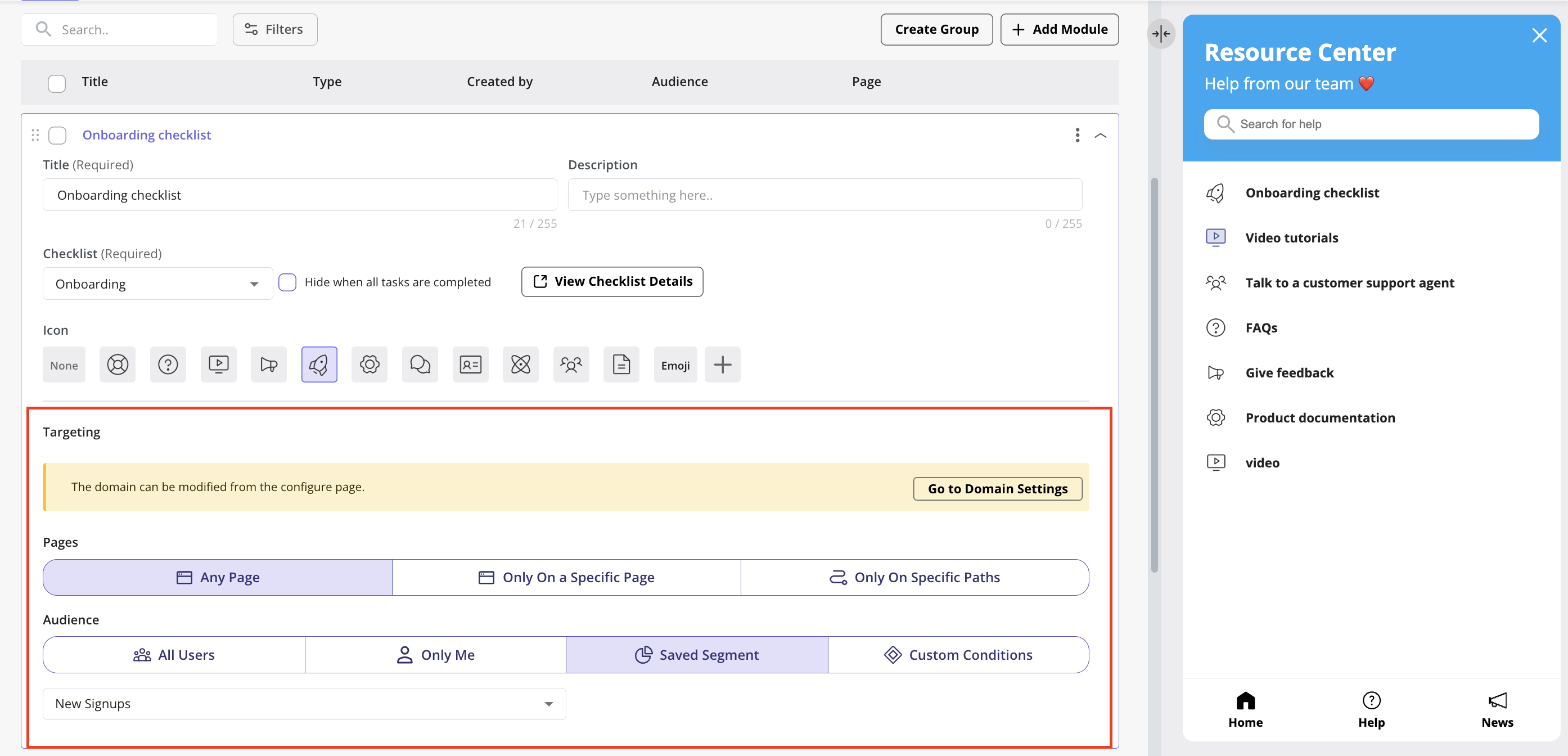
Help module visibility condition settings.
- Resource center analytics dashboard: The dedicated analytics dashboard helps you see how many unique visitors your resource center gets, how many modules have been clicked, the overall click rate across your user base, and popular search terms. This will make it easier to gauge resource center performance and identify if anything is missing from your resource center.

Resource center content analytics in Userpilot.
Pricing of Userpilot
Userpilot’s transparent pricing ranges from $249/month on the entry-level end to an Enterprise tier for larger companies.
Furthermore, Userpilot’s entry-level plan includes access to all UI patterns and should include everything that most mid-market SaaS businesses need to get started.

Userpilot has three paid plans to choose from:
- Starter: The entry-level Starter plan starts at $249/month and includes features like segmentation, product analytics, reporting, user engagement, NPS feedback, and customization.
- Growth: The Growth plan starts at $749/month and includes features like resource centers, advanced event-based triggers, unlimited feature tagging, AI-powered content localization, EU hosting options, and a dedicated customer success manager.
- Enterprise: The Enterprise plan uses custom pricing and includes all the features from Starter + Growth plus custom roles/permissions, access to premium integrations, priority support, custom contract, SLA, SAML SSO, activity logs, security audit, and compliance (SOC 2/GDPR).
Product Fruits vs UserGuiding
There are many ways how UserGuiding is different (and in a lot of ways better!) from Product Fruits. Let’s explore the features of UserGuiding, how it’s better than Product Fruits, and how it may fall short too.
UserGuiding for user onboarding
As a no-code onboarding tool, UserGuiding has numerous features that will help you create onboarding flows for your new customers and guide them throughout their journey.
Here’s what you’ll get when you start using UserGuiding:
- Create interactive product walkthroughs without disturbing your developers as it’s completely code-free.
- Build onboarding checklists and drive customers to the activation point by eliminating the guesswork on what the next step should be.
- Create interactive elements, such as product tours, tooltips, and pop-ups, to help keep users engaged and increase the likelihood that they’ll complete the onboarding process.
- Create a resource center to add different educational resources for your users.
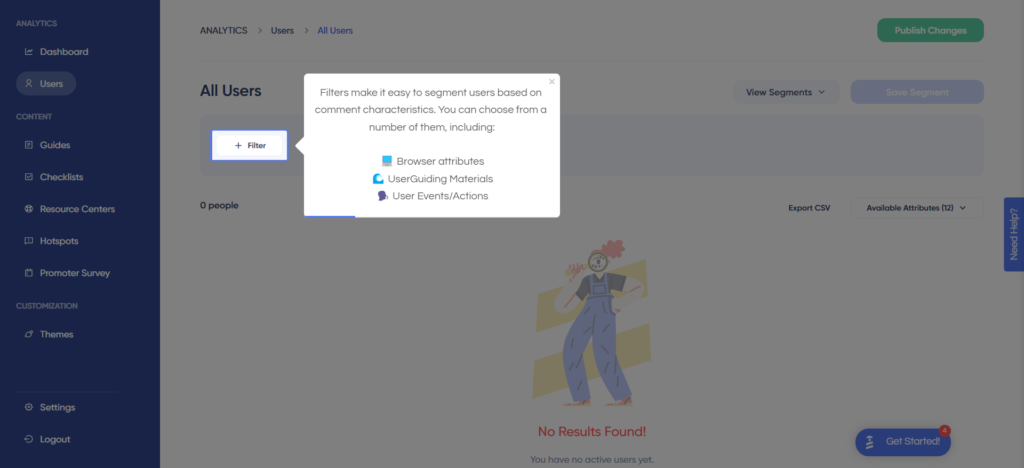
Though UserGuiding is a great tool for startups that don’t have much money to invest in an onboarding tool, it has very strict limitations for the Basic plan.
You can only create a maximum of 20 guides and hotspots, 2 onboarding checklists, and 1 resource center. If you want to create unlimited guides with unlimited UI patterns, you should go for the Professional plan which can cost from $299 to $399.
The one drawback when using UserGuiding for onboarding is the fact that its analytics dashboard only encompasses the elements that you’ve created within the platform. In contrast, Userpilot is able to track all elements, events, and behaviors throughout the entire user journey.
UserGuiding for product analytics
Product analytics are a cornerstone of any growth strategy as they offer insights into how existing customers have used the product. They can also highlight similarities between users within certain cohorts (such as power users or churned customers).
Unfortunately, UserGuiding has no native product analytics capabilities. The only data it’s able to collect are interactions with UserGuiding materials such as guides, checklists, hotspots, or resource centers.
It does have integrations with analytics platforms like Amplitude, Mixpanel, Segment, and Woopra. However, the depth and flexibility vary from integration to integration — not to mention the fact that you’ll need to pay extra for a standalone analytics product before you can integrate it.

UserGuiding for self-service support
As an onboarding solution, UserGuiding is targeted toward the initial tours, walkthroughs and flows that new users go through. However, it does have certain customer education features that could be utilized in the context of self-service support: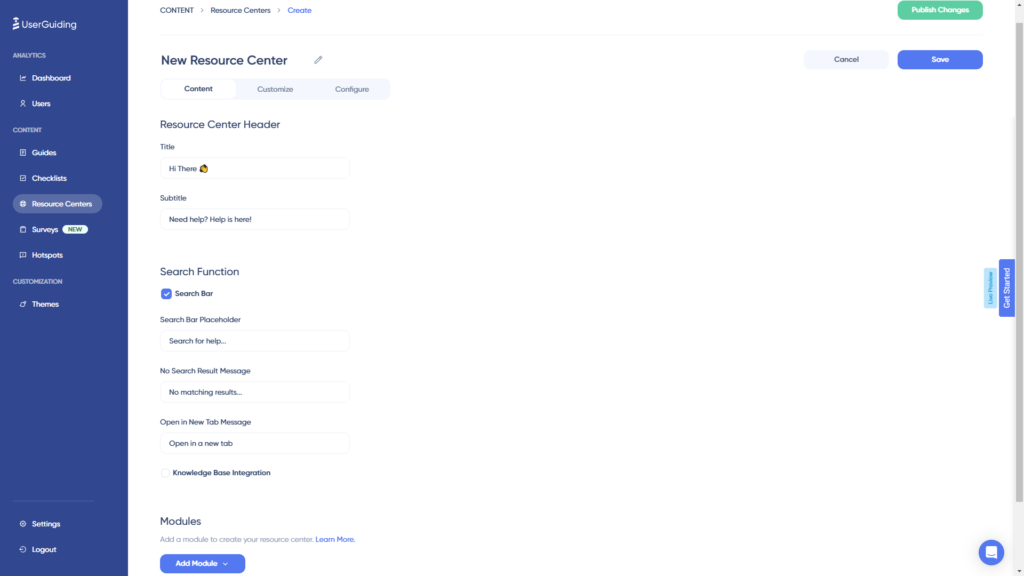
- Resource Center: The most suitable UserGuiding feature for self-service support is the resource center. Resource centers created with UserGuiding are also equipped with a search function to help users find the resources that they need.
- Localization: Self-service support can be tricky if your product has a multilingual user base, but UserGuiding does have localization features that can help with that. It’s worth noting that the localization is NOT automated, so you’ll need to manually download, translate, and upload CSVs.
- Analytics: UserGuiding’s analytics dashboard shows you how many interactions your resource center has had in the past seven days, which can be useful when trying to measure engagement with self-service resources.
Pricing of UserGuiding
UserGuiding has three plans to choose from, targeted towards a range of business sizes from startup to enterprise.
Here are UserGuiding’s specific pricing details:
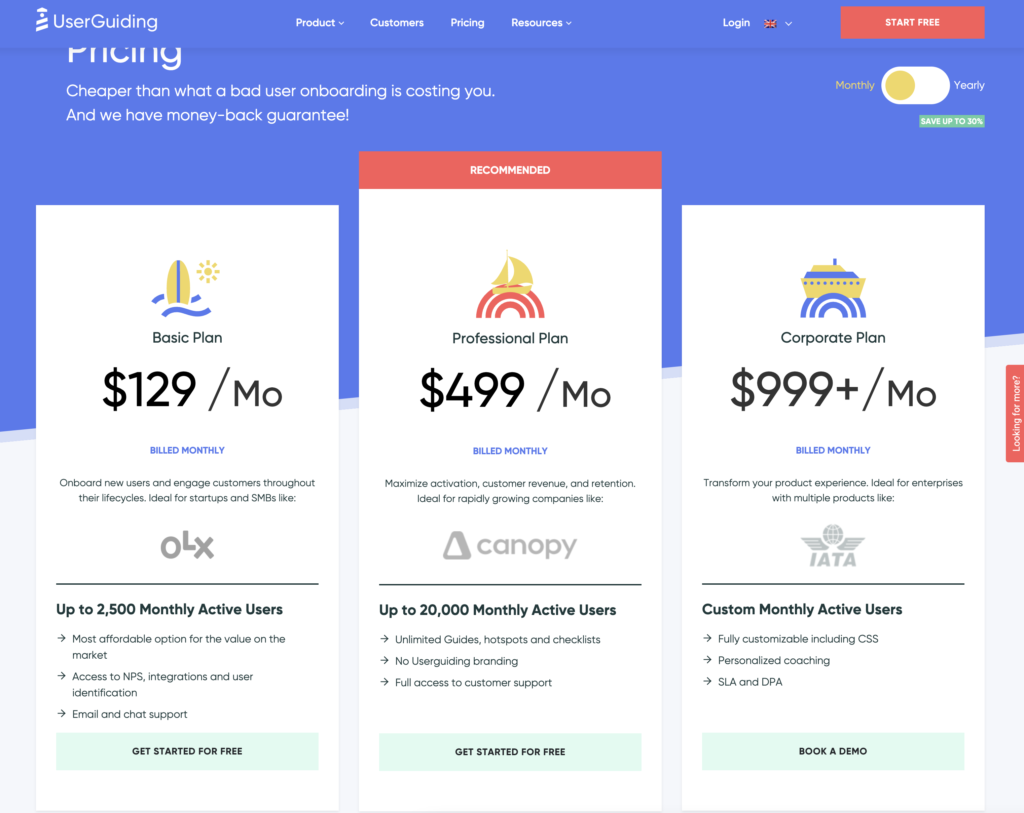
- Basic: Costing $129/month, the Basic plan is targeted towards startups and SMBs. The Basic plan is quite limited as it caps your account at one active survey, two active checklists, and no more than 2,500 MAUs. Features include:
- Access to user identification features.
- Integrations with Google Analytics, HubSpot, Intercom, and more.
- Email and chat support.
- Customizable theme (only one).
- Professional: The Professional plan costs almost 4x as much as the Basic tier at $499/month. That said, it significantly increases capacity to 20,000 MAUs and improves the quality of customer support you’ll receive. Features include:
- Removal of UserGuiding branding.
- Language localization.
- Full customer support access.
- Five team member seats.
- Five customizable themes.
- Unlimited guides and checklists.
- Corporate: Subscriptions on the Corporate plan start at $999/month. Of course, this higher price does come with its fair share of enterprise perks. Features include:
- Service Level Agreement (SLA) + Data Processing Agreement (DPA).
- Up to 10 active surveys.
- Custom MAU capacity based on your needs.
- Unlimited team member seats.
- Unlimited customizable themes.
All monthly plans are marked down by 30% when customers choose to bill annually.
Product Fruits vs Userflow
There are many ways how Userflow is different (and in a lot of ways better!) from Product Fruits. Let’s explore the features of Userflow, how it’s better than Product Fruits, and how it may fall short too.
Userflow for user onboarding
Userflow positions itself as a user onboarding tool, so most of its features are targeted towards that use case. Here are the Userflow features and functionalities that you can use to onboard new users to your product:
- Flows: In-app flows are the primary user onboarding feature that Userflow offers. You’ll be able to add steps like speech bubbles, tooltips, modals, or hidden steps used as triggers. You can also select whether a step is mandatory for flow completion and change the size or theme if needed.

- Targeting: You can create personalized and contextual onboarding flows with Userflow due to its auto-start settings. You can add trigger conditions like what page users are on, which segment they’re in, when they signed up, which elements they’ve clicked, and which flows they’ve seen.
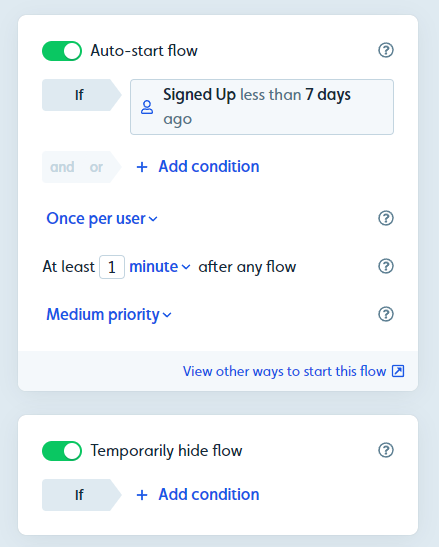
- Checklists: Userflows lets you create checklists with an unlimited number of tasks, trigger them if certain targeting conditions are met, configure whether tasks need to be completed in a specific order, and prevent users from dismissing the checklist if needed.
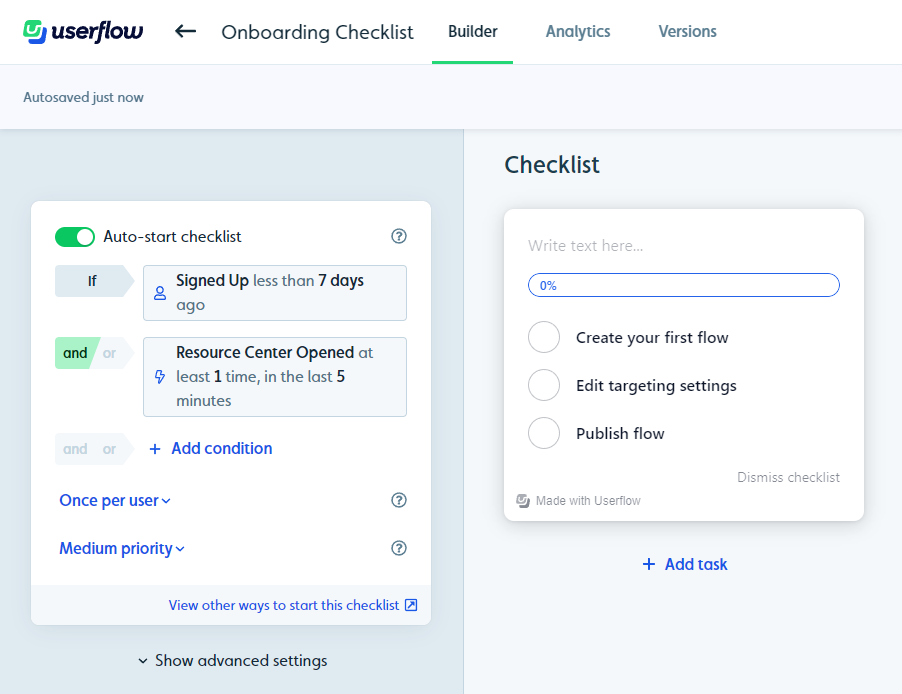
Userflow for product analytics
Product analytics are essential for optimizing user acquisition, activation, and retention. Unfortunately, Userflow doesn’t have any native product analytics capabilities as it only provides data for how users interact with your flows, checklists, launchers, resource centers, and NPS surveys.
One workaround would be to integrate your Userflow account with analytics tools like Amplitude, Mixpanel, or Heap. However, this may not be very cost-effective as you’d need to pay extra to subscribe to these third-party analytics tools.
Note: Advanced integrations (the ability to build custom integrations between Userflow and a third-party app) are locked behind the Pro plan which starts at $680/month and is almost 3x more expensive than Userflow’s entry-level Startup plan.
Userflow for self-service support
Self-service support decreases ticket volume and increases satisfaction levels. Userflow can aid self-service support through flows that teach users about a specific feature, checklists that guide them to their next step, and resource centers with documentation.
Here are the Userflow features you can use to build a self-service customer experience:
- In-app guides: Userflow lets you create in-app flows with tooltips, modals, and speech bubbles that guide users. You can even trigger flows whenever certain conditions are met, such as a user opening the resource center in the past hour while on a specific page.
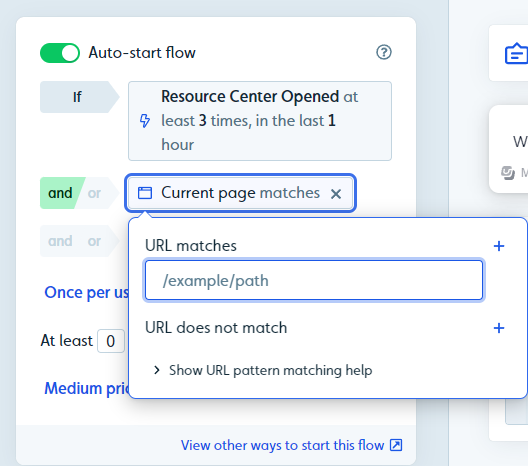
- Onboarding checklists: New users are the segment most likely to need support. Userflow lets you create onboarding checklists with unlimited tasks. You’ll also be able to use the completion of checklists as a condition to trigger in-app flows or show/hide certain resource center blocks.
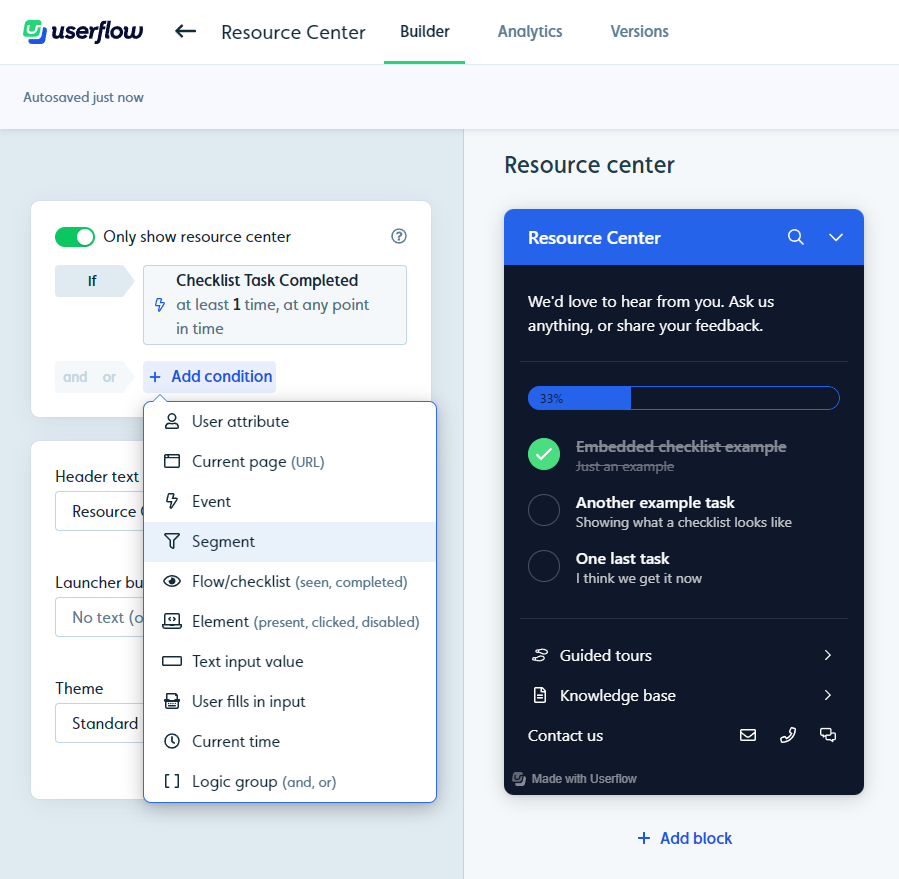
- Resource centers: Userflow in-app resource centers can include blocks like checklists, help articles, free-form content, checklists, announcements, and flow triggers. You can also style the resource center with custom themes or hide/show blocks when specific conditions are met.

- Live chats: You can leverage Userflow integrations like Crisp, Zendesk, Freshchat, Help Scout, HubSpot, or Intercom to give customers an option to connect to an actual human if self-service resources don’t solve their problem.
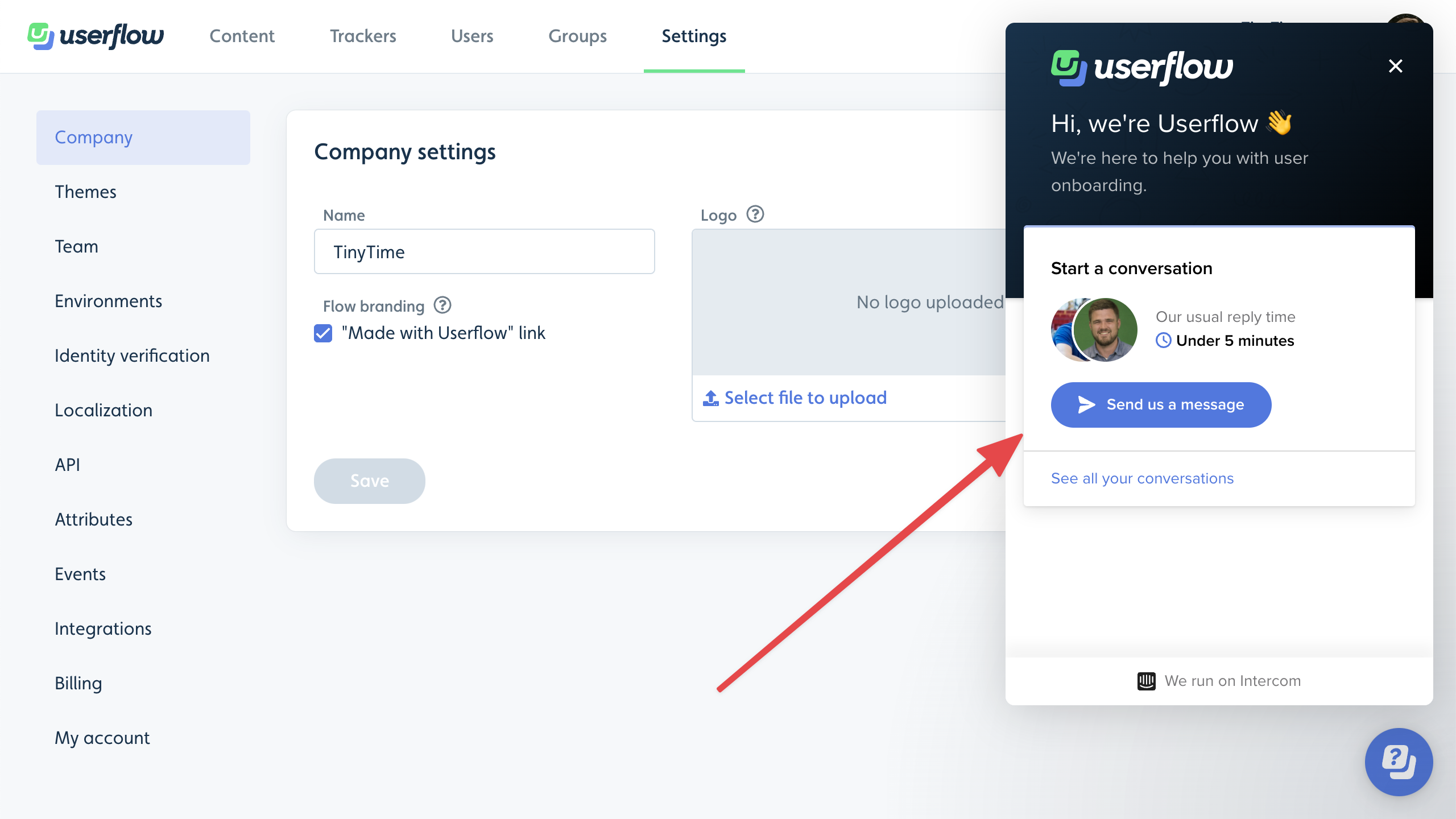
Pricing of Userflow
Userflow has three paid plans — Startup, Pro, and Enterprise — that start at $240 and increase in price as your MAUs grow. For example, the Startup plan costs over $1,000/month once you reach 50,000 MAUs which could make it difficult for products with thousands of freemium users to scale.
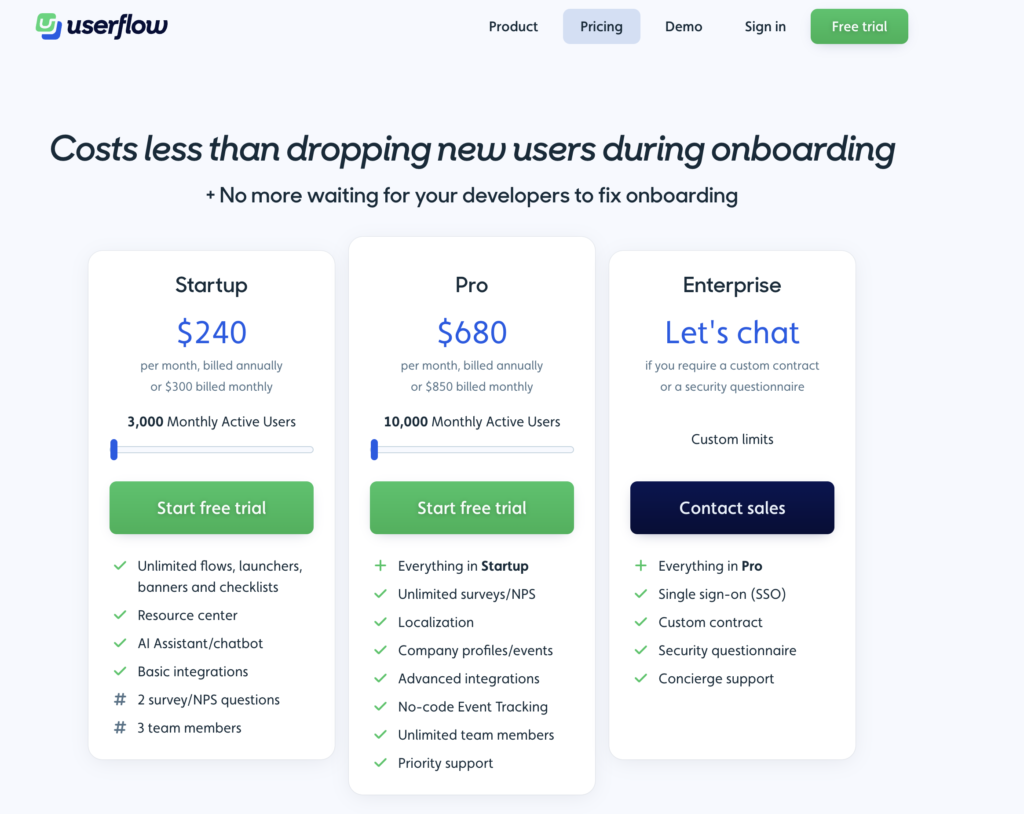
Here’s a closer look at each of Userflow’s plans:
- Startup: Userflow’s entry-level Startup plan starts at $240/month for 3,000 MAUs. Due to the survey and team size limitations of the Starter plan, you’ll likely need to upgrade to Pro at some point or purchase additional seats for $20/month each.
- Pro: Userflow’s Pro plan costs almost three times as much at $680/month for 10,000 MAUs. It contains essential features like localization, advanced integrations, event tracking, and unlimited surveys so you’ll probably need to upgrade to this tier eventually to continue growing.
- Enterprise: Userflow’s Enterprise tier is priced on a quote basis and can accommodate a custom number of MAUs. It comes with benefits like concierge support, security questionnaires, custom contracts, and single sign-on (SSO) features.
Product Fruits vs Whatfix
There are many ways in which Whatfix is different (and in a lot of ways better!) from Product Fruits. Let’s explore the features of Whatfix, how it’s better than Product Fruits, and how it may fall short too.
Whatfix for user onboarding
User onboarding is a complex process that only the most flexible tools can pull off. Whatfix has its fair share of bugs and technical quirks but there are a few features that bolster its onboarding capabilities — namely its tours, checklists, and integrations.
Here’s an overview of Whatfix’s onboarding features:
- Whatfix lets you create interactive product tours for both users and employees. This reduces the time to value (TTV), whether it’s for customers using your product or employees learning how to use a solution in the internal tool stack.
- Onboarding checklists (known as task lists on Whatfix) give new users or employees a clear next step on their journey toward product adoption. Whatfix lets you create these checklists as widgets target specific segments, and group tasks under headers.
- Whatfix’s gallery of direct integrations with tools like Salesforce, Amplitude, SurveyMonkey, and more helps you centralize all onboarding data. The onboarding metrics gathered and synced across tools can then help you streamline your in-app flows.
Whatfix for product analytics
Whatfix has a separate product analytics solution that is billed separately from its mainline digital adoption platform (but has no pricing listed on the website).
Here’s an overview of Whatfix’s product analytics capabilities:
- Whatfix has both trend and funnel report types available which can help you see how your customers or employees use different software applications. This will show you which paths users take, which elements they interact with, and what browser/OS they use to do so.
- Track user properties like the type of device they’re on, which browser they’re using, or where they’re from. Unfortunately, this data isn’t available for desktop-based applications.
- Limitations: Whatfix analytics lacks clarity and scalability (especially on the entry-level plan). Those on the Standard plan can only tag 25 actions and there’s no indication of how much it will cost to lift that limit by upgrading.
Whatfix for self-service support
Providing self-service options for employees and customers is crucial for multiple reasons. Mainly, it speeds up the product adoption process while simultaneously reducing the workload for your support team. Whatfix lets you offer multiple types of self-service support.
Here’s an overview of Whatfix’s self-service support functionality:
- In-App Guidance: Whatfix’s in-app guidance features can be used to show customers or employees how to use a particular application. These flows could go over specific processes, highlight individual features, or serve as a walkthrough for the overall onboarding sequence.
- Contextual Help: You can use Whatfix to provide contextual support to users when they need it most, so they don’t need to take up your team’s time by submitting tickets. These self-help resources make the answer to common queries easily accessible from anywhere on the web.
- Multi-Channel Support: Whatfix gives you the ability to provide technical support throughout every touchpoint your organization uses. This includes email, chat, social media, support platforms, or other channels that the company utilizes to assist users.
Pricing of Whatfix
Whatfix doesn’t have public pricing listed on its website. It also charges separately for its product analytics solution but we won’t be going over those plans since we’re focusing on the digital adoption platform.
Here’s an overview of the three plans available for Whatfix web:
- Standard: This includes core features like in-app guidance, contextual guidance, a multi-media knowledge base, and content aggregation capabilities. It also includes access to pre-built surveys and up to two integrations.
- Premium: This includes additional features such as automatic content localization, automated flow testing, unlimited integrations, and single sign-on (SSO). You’ll also be able to build custom surveys while on the Premium plan.
- Pro: This includes the features from previous plans as well as enterprise-exclusive options such as self-hosting. This plan is targeted towards customer-facing applications with a million or more users.
Conclusion
As you can see, there are many different competitors and alternatives to Product Fruits. We’ve discussed a few above – but which one is the best?
The answer is “it depends” – but we strongly believe that if you’re a mid-market SaaS company looking for a great user onboarding and product analytics tool, Userpilot is the best option for you.
Hopefully, you found this post helpful. And if you need any help with how Userpilot is different, schedule a demo to get started!


